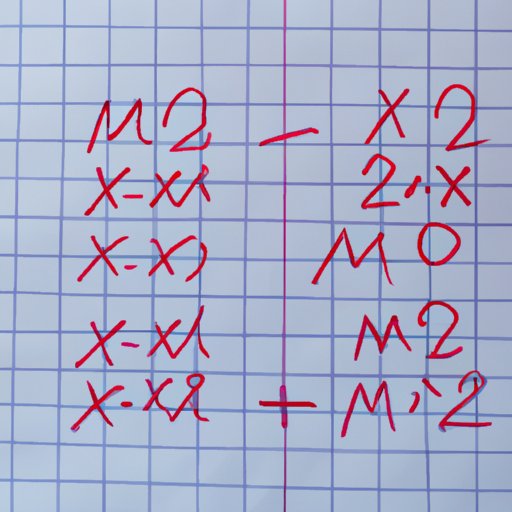
I. Introduction
Long multiplication is one of the foundational skills in mathematics – it’s the calculation of large numbers by breaking them down into smaller, more manageable pieces. Being able to do long multiplication accurately is an important skill to learn because it sets the foundation for more complex math concepts. In this article, we’ll explore a step-by-step guide to long multiplication, common mistakes to avoid, fun ways to learn, and its real-life applications. We’ll also delve into the history of long multiplication, how to teach it to others, and how it relates to other mathematical concepts.
II. A step-by-step guide to long multiplication
The process of long multiplication can seem daunting at first, but when broken down into clear steps, it becomes much more manageable. Here’s how it works in six easy steps:
- Write the two numbers being multiplied next to each other, with the larger number on top and the smaller number on the bottom.
- Multiply the last digit of the bottom number by each digit of the top number, writing each result below the line and shifting over one space to the left for each new digit.
- Add the results from step two together.
- Multiply the second-to-last digit of the bottom number by each digit of the top number, writing each result below the line and shifting over one space to the left for each new digit.
- Add the results from step four together.
- Repeat the process until all digits have been multiplied and added.
It’s important to follow these steps accurately to get the correct answer. Using images or videos as visual aids can also be helpful in understanding the process.
III. Common mistakes to avoid when doing long multiplication
Even the most seasoned mathematicians can make mistakes when doing long multiplication. Here are some of the most common errors and tips for avoiding them:
- Forgetting to line up the digits correctly – make sure the place values match up.
- Skipping a step or repeating a step – it’s important to follow the steps accurately.
- Misplacing a digit or forgetting to carry – double-check each step as you go along.
- Using the wrong operation – make sure you’re multiplying, not adding or subtracting.
Practicing often and double-checking your work can prevent these types of errors.
IV. Fun ways to learn long multiplication
Learning long multiplication doesn’t have to be boring – there are many alternative ways to teach and practice the skill. Some suggestions include:
- Using math manipulatives, such as blocks or beads, to physically represent the numbers being multiplied.
- Playing multiplication games, such as bingo or card games.
- Using online tools, such as interactive multiplication games or apps.
- Creating a multiplication chart or flashcards to practice and memorize the times tables.
By making learning fun and engaging, it can be easier to stay motivated and retain the information.
V. The history of long multiplication
The process of long multiplication has been around for thousands of years, dating back to ancient civilizations such as the Egyptians and Babylonians. However, the modern process we use today was developed in Europe during the 13th and 14th centuries. Notable mathematicians, such as Fibonacci and Isaac Newton, contributed to its development. Today, long multiplication is still a crucial skill in mathematics, used in many real-life applications.
VI. How to apply long multiplication to real-life situations
Long multiplication has many practical uses in everyday life. Some examples include:
- Calculating discounts or sales tax when shopping.
- Splitting a restaurant bill evenly among a group of people.
- Determining the total cost of a project, such as home renovation.
These are just a few examples of how long multiplication can be useful in daily life. Being able to quickly and accurately calculate numbers can save time and money.
VII. How to teach long multiplication to someone else
Teaching long multiplication to someone else, whether it’s a child or an adult, can be challenging. Here are a few tips for making the process easier:
- Break down the process into simple steps.
- Use visual aids, such as diagrams or manipulatives.
- Provide plenty of practice opportunities.
- Be patient and supportive.
Everyone learns at their own pace, so it’s important to be flexible and provide plenty of encouragement along the way.
VIII. How long multiplication relates to other mathematical concepts
Long multiplication is a foundational skill that connects to many other math concepts. For example:
- Division – the inverse of multiplication.
- Fractions – multiplying fractions requires long multiplication.
- Algebra – multiplying variables follows the same principles as multiplying numbers.
By understanding how long multiplication relates to other math concepts, it becomes easier to grasp and apply those concepts in real-life situations.
IX. Conclusion
Long multiplication may seem intimidating at first, but with practice and persistence, it can become a valuable and even enjoyable skill. By following a step-by-step guide, avoiding common mistakes, and exploring fun ways to learn, anyone can master long multiplication. The history of the skill, its real-life applications, and its connection to other mathematical concepts only add to its importance. Whether you’re learning long multiplication for the first time or teaching it to someone else, remember to be patient, supportive, and to never stop learning.





